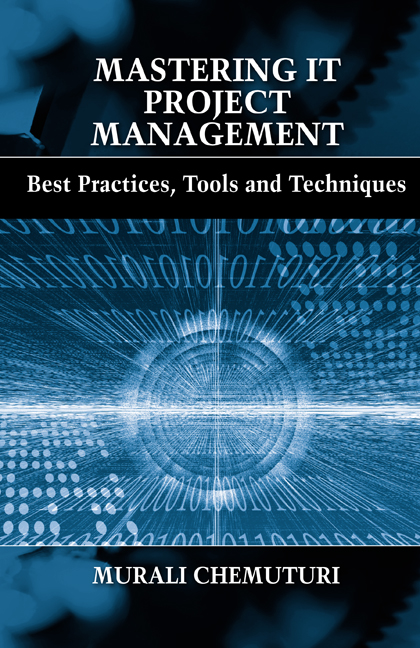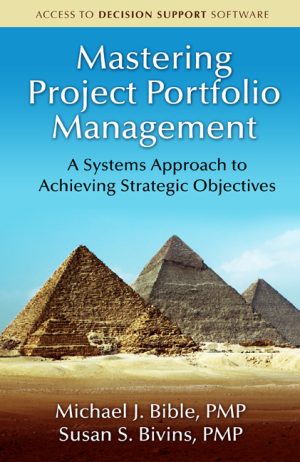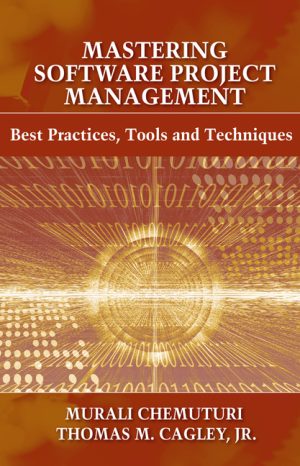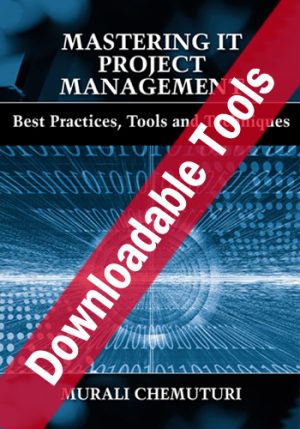Mastering IT Project Management
$59.95
Best Practices, Tools and Techniques
By Murali Chemuturi
Hardcover, 6 x 9, 384 pages
ISBN: 978-1-60427-078-5
July 2013
LEARN & EARN: Get 6.6 PDUs in the PMI skill areas of Technical or Strategic and Business Management Skills
Description
In previous years, setting up IT infrastructure involved just the preparation of the data center. It has become much more complex and evolved today. The infrastructure includes not only the data center facility, but also the entire organization by providing internet connectivity to customers, vendors, and company executives on the move. Mastering IT Project Management is the first book to detail how to create IT infrastructure rather than simply describe how to manage the IT function or software development. This unique and comprehensive reference covers all aspects needed to successfully manage this type of project in an organization.
Key Features
- Outlines a process-based approach for setting up effective IT infrastructures in organizations
- Provides a thorough discussion on conducting a feasibility study for setting up IT infrastructure, sizing of IT components, and quality assurance
- Explains numerous management concepts, decision making, people management, problem resolution, cash management and stakeholder expectation management
- Covers planning, scheduling, executing, controlling and project closure
- Gives insights into industry best practices and the common pitfalls in setting up an IT infrastructure
- WAV offers a downloadable sample schedule for a typical IT project, numerous planning, managing and reporting templates, and a personal effectiveness software tool—available from the Web Added ValueTM Download Resource Center
About the author(s)
Murali Chemuturi is a project management, information technology and software development subject matter expert, hands-on programmer, author, consultant and trainer. In 2001, he formed Chemuturi Consultants which offers information technology and software development consulting and training to organizations in the United States and India. He has over 15 years of engineering experience and more than 26 years of IT and software development experience. His most recent position prior to forming his own firm was Vice President of Software Development at Vistaar e-Business Pvt., Ltd. Mr. Chemuturi earned undergraduate degrees in both Electrical and Industrial Engineering, an MBA, and a Post Graduate Diploma in Computer Methods & Programming. Chemuturi also has several years of academic teaching experience and has taught a variety of computer & IT courses such as COBOL, Fortran, BASIC, Computer Architecture, and Database Management Systems. Murali is a well published author in professional journals and has authored three highly regarded books. In 2009, Mr. Chemuturi wrote his first book, Software Estimation Best Practices, Tools, & Techniques, and followed with two other equally successful books in 2010, Mastering Software Project Management and Mastering Software Quality Assurance. Mr. Chemuturi remains active in professional societies as well. He is a senior member of IEEE, a senior member of the Computer Society of India, and a Fellow of the Indian Institute of Industrial Engineering.
Table of Contents
Chapter 1–Introduction to IT Project Management
Introduction
Components of IT Infrastructure
Classification of Organizations
Understanding Project Management
Activities to be Performed in an IT Project
Phases of an IT Project
Types of IT Projects
Distinction of IT Projects from Other Projects
Chapter 2–Approaches to IT Project Management
Project Management Approaches
Ad Hoc Methods-Based Project Management
Process Driven Approach to Project Management
Schedule-Driven Approach
Hybrid of Ad Hoc and Process-Driven Approach
What Is the Right Approach for Project Management?
Is the Process-Driven Approach Right for You?
What Process and How Much?
Chapter 3–Feasibility Study and Project Acquisition
Do We Need a Feasibility Study in These Days?
The First Decision—In-House or Outsource the Study?
Steps in Conducting the Feasibility Study
Project Approval
Strategies for Executing the IT Projects
Project Acquisition
Chapter 4–Sizing of IT Components
Introduction to Sizing
Software First or Hardware?
Availability of the System
Sizing of the Server
Power Requirements
Software Sizing
Contracting
Chapter 5–Planning in IT Project Management
Introduction
Definition of Planning
Types of Plans Prepared by Software Project Management
Quality Control of Planning
Scaling of Planning in IT Project Management
Funds Flow Planning
Chapter 6–Project Execution
Introduction
Procurement of Hardware
Procurement of System Software
Preparation of Specifications and Acquisition of Application Software
Finalize Subcontractors
Receive and Deploy Servers
Receive Networking Hardware and Build the Communication Network
Receive and Deploy the System Software
Prepare Master Data
Receive and Deploy Application Software
Define Systems and Procedures for Running the Operations
Recruiting and Training Personnel for Operations
Procure Consumables for the Initial Operation
Contract/Contractor Management
Setup Configuration Management Process
Train End Users in Operating the System
Conduct Trial Runs
Changeover to New System
Initiate Maintenance When Would All These Actions Be Taken? How about Quality Control?
Coordination
Chapter 7–Project Control in IT Project Management
Introduction
Schedule Control
Cost Control
Quality Control
Productivity Control
Tools and Techniques for Project Control
Progress Monitoring Meetings
Metrics
Earned Value Analysis
Audits
Chapter 8 – Cash Management
Introduction
Elements of Cash Management
Budgeting
Cash Management
Chapter 9–Quality Assurance in IT Project Management
Introduction
Environment Conducive to Quality
Organizational Process
Standards and Guidelines
Measurement and Metrics
Verification
Inspections
Validation Audits
Chapter 10–Project Closure
Introduction
When Does a Project Really Close?
Project Closure Activities
Documentation of Best Practices
Documenting the Lessons Learned from the Project
Collect, Derive, and Deposit the Final Project Metrics
Conduct a Knowledge-Sharing Meeting with Peer Project Managers
Deposit the Project Records with the PMO
Project Postmortem
Performance Appraisals of the Project Team
Release of the Project Manager
Close the Project
Organizational Role in Project Closure
Chapter 11–Pitfalls and Best Practices in Project Management
Introduction
Organizational-Level Pitfalls in Project Management
Pitfalls and Best Practices at the PM Level
Appendix A–Management for Project Managers
Appendix B–Decision Making for Project Managers
Appendix C–People Management
Appendix D–Introduction to PERT/CPM
Appendix E–Problem Resolution
Appendix F–Stakeholder Expectation Management
Appendix G–Scheduling
Appendix H–Abbreviations
Appendix I–Templates for IT Project Management
Reviews
“Mastering IT Project Management is the definitive source of knowledge for managing all phases of IT infrastructure projects. Despite my decades of experience, this resource discusses several areas that I never considered and would have helped many of my projects go much smoother. This is a must read and heed!” —Robert C. Anderson, Director, Process Development & Quality Assurance, Computer Aid Inc.
“Mastering IT Project Management provides a full spectrum, step-by-step, how-to approach that arms both novices and gurus with best practices, tools, and techniques that allow them to emerge victorious.”—Pat O’Toole, CMMI High Maturity Lead Appraiser
You may also like…
Related products
-
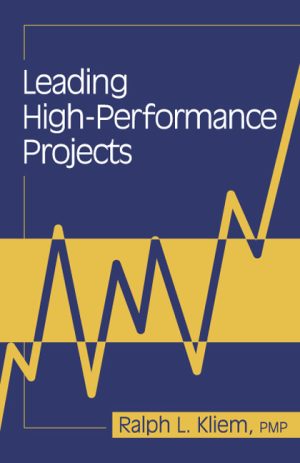
Leading High-Performance Projects
Retail Price: $44.95$39.95 Add to cart -
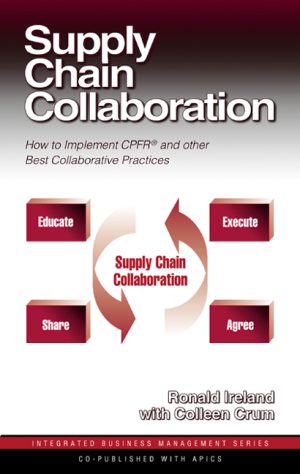
Supply Chain Collaboration
Retail Price: $54.95$49.95 Add to cart -
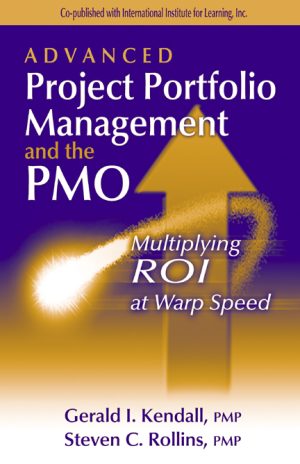
Advanced Project Portfolio Management and the PMO
Retail Price: $74.95$59.95 Add to cart -

The Networked Supply Chain
Retail Price: $54.95$44.95 Add to cart -

Distressed Debt Analysis
Retail Price: $119.95$99.95 Add to cart

